Archives
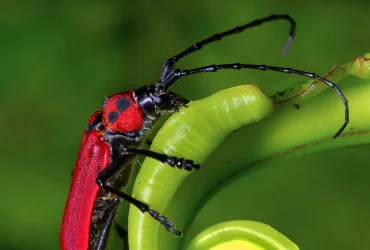 v5i1.99
v5i1.99ISSN: 1800-427X (print)
eISSN: 1800-427X (online)
DOI:10.47605/tapro.v5i1.99
Submitted date: 2 April 2012
Accepted date: 20 April 2013
Published date: 15 June 2013
Pp. 85–86.
The small flying squirrel (Petinomys fuscocapillus) observed after 78 years in Sri Lanka
R.P. Nanayakkara, N. Vishvanath & T.G.T. Kusuminda*
*Corresponding author. E-mail: t.kusuminda@gmail.com
Petinomys fuscocapillus (Kelaart, 1852) is one of two nocturnal Squirrels found in Sri Lanka, and the distribution of the species is only known through a few possible occurrences and museum specimens which were collected nearly hundred years ago. The species was considered to be extinct in India until 1989, when it was rediscovered in a coconut grove in Kerala state, India. In Sri Lanka it was reported by Phillips (1935) from the wet and intermediate zones of the island, and subsequently the occurrence of this species was confirmed by camera trap by Jayasekara et al. (2007) in Sinharaja tropical rain forest. Here we report the first physical examination of this species in Sri Lanka after 78 years, and we publish the first color–photographs. The authors obtained a direct sighting of the Small flying squirrel in the Knuckles Forest Reserve at an elevation of 522 m asl.
Section Editor: Colin P. Groves
eISSN: 1800-427X (online)
DOI:10.47605/tapro.v5i1.99
Submitted date: 2 April 2012
Accepted date: 20 April 2013
Published date: 15 June 2013
Pp. 85–86.
The small flying squirrel (Petinomys fuscocapillus) observed after 78 years in Sri Lanka
R.P. Nanayakkara, N. Vishvanath & T.G.T. Kusuminda*
*Corresponding author. E-mail: t.kusuminda@gmail.com
Petinomys fuscocapillus (Kelaart, 1852) is one of two nocturnal Squirrels found in Sri Lanka, and the distribution of the species is only known through a few possible occurrences and museum specimens which were collected nearly hundred years ago. The species was considered to be extinct in India until 1989, when it was rediscovered in a coconut grove in Kerala state, India. In Sri Lanka it was reported by Phillips (1935) from the wet and intermediate zones of the island, and subsequently the occurrence of this species was confirmed by camera trap by Jayasekara et al. (2007) in Sinharaja tropical rain forest. Here we report the first physical examination of this species in Sri Lanka after 78 years, and we publish the first color–photographs. The authors obtained a direct sighting of the Small flying squirrel in the Knuckles Forest Reserve at an elevation of 522 m asl.
Section Editor: Colin P. Groves
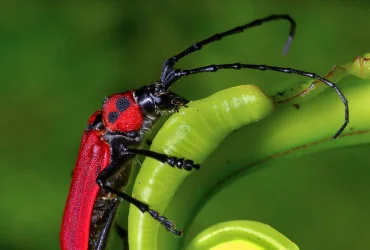 v5i1.98
v5i1.98ISSN: 1800-427X (print)
eISSN: 1800-427X (online)
DOI:10.47605/tapro.v5i1.98
Submitted date: 7 January 2012
Accepted date: 25 January 2013
Published date: 15 June 2013
Pp. 81–84.
The Indian Golden Gecko, Calodactylodes aureus (Beddome, 1870) in Tamil Nadu, India
A. Kalaimani* & A. Nath
*Corresponding author. E-mail: manikalai16@yahoo.com
The gekkonid lizard genus Calodactylodes Strand, 1926 is endemic to peninsular India and Sri Lanka. Calodactylodes aureus (Beddome, 1870), the first described species in the genus, was originally recorded from the Tirupati Hills, Andhra Pradesh state in India. In Andhra Pradesh, in addition to the type locality, it is recorded from the Araku Valley and the Ananthagiri Hills both in the Visakhapatnam District, from Perantalapally in the Khammam District, from Maredumilli in the East Godavari District, the Seshachalam Hills in Chittoor and Kadapa Districts and the Tirumala Hills in Chittoor District. In Orissa state the species has been reported from Rayagada and Kalahandi Districts in the Niyamgiri Hills. Finally, in the state of Tamil Nadu the species has been recorded from the Balamathi, Valli Malai and Sathgar Hills in Vellore District, Nedumkunam Hill in Tiruvannamalai District and Shyed Basha Malai in Krishnagiri District.
Section Editor: John Rudge
eISSN: 1800-427X (online)
DOI:10.47605/tapro.v5i1.98
Submitted date: 7 January 2012
Accepted date: 25 January 2013
Published date: 15 June 2013
Pp. 81–84.
The Indian Golden Gecko, Calodactylodes aureus (Beddome, 1870) in Tamil Nadu, India
A. Kalaimani* & A. Nath
*Corresponding author. E-mail: manikalai16@yahoo.com
The gekkonid lizard genus Calodactylodes Strand, 1926 is endemic to peninsular India and Sri Lanka. Calodactylodes aureus (Beddome, 1870), the first described species in the genus, was originally recorded from the Tirupati Hills, Andhra Pradesh state in India. In Andhra Pradesh, in addition to the type locality, it is recorded from the Araku Valley and the Ananthagiri Hills both in the Visakhapatnam District, from Perantalapally in the Khammam District, from Maredumilli in the East Godavari District, the Seshachalam Hills in Chittoor and Kadapa Districts and the Tirumala Hills in Chittoor District. In Orissa state the species has been reported from Rayagada and Kalahandi Districts in the Niyamgiri Hills. Finally, in the state of Tamil Nadu the species has been recorded from the Balamathi, Valli Malai and Sathgar Hills in Vellore District, Nedumkunam Hill in Tiruvannamalai District and Shyed Basha Malai in Krishnagiri District.
Section Editor: John Rudge
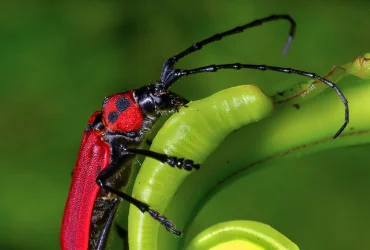 v5i1.97
v5i1.97ISSN: 1800-427X (print)
eISSN: 1800-427X (online)
DOI:10.47605/tapro.v5i1.97
Submitted date: 11 November 2012
Accepted date: 13 January 2013
Published date: 15 June 2013
Pp. 77–80.
The confirmed record of Oligodon albocinctus (Cantor, 1839) from Bangladesh
M.K. Hasan*, M.M. Feeroz, S. Ahmed, A. Ahmed & S. Saha
*Corresponding author. E-mail: mkhasan@ucdavis.edu
Oligodon albocinctus (Cantor, 1839) has been recorded in Assam, Sikkim and Arunachal Pradesh of India, Nepal, Myanmar and China. Khan (1982, 2010) included this species as common and found in the north and east of Bangladesh. However Sarker & Sarker (1985, 1988) did not include this species in their checklists of the snakes of Bangladesh. The IUCN local red list (2003) included this species as data deficient. Khan (2008) stated that this species was expected to be found in Bangladesh. Kabir et al. (2009) included this species in the Encyclopedia of Flora and Fauna of Bangladesh based on IUCN Bangladesh (2003). However none of the previous reports were based on a specimen or photographic evidence, hence this is the first confirmed record of Oligodon albocinctus from Chunati Wildlife Sanctuary, Bangladesh, with a specimen and photographs.
Section Editor: Gernot Vogel
eISSN: 1800-427X (online)
DOI:10.47605/tapro.v5i1.97
Submitted date: 11 November 2012
Accepted date: 13 January 2013
Published date: 15 June 2013
Pp. 77–80.
The confirmed record of Oligodon albocinctus (Cantor, 1839) from Bangladesh
M.K. Hasan*, M.M. Feeroz, S. Ahmed, A. Ahmed & S. Saha
*Corresponding author. E-mail: mkhasan@ucdavis.edu
Oligodon albocinctus (Cantor, 1839) has been recorded in Assam, Sikkim and Arunachal Pradesh of India, Nepal, Myanmar and China. Khan (1982, 2010) included this species as common and found in the north and east of Bangladesh. However Sarker & Sarker (1985, 1988) did not include this species in their checklists of the snakes of Bangladesh. The IUCN local red list (2003) included this species as data deficient. Khan (2008) stated that this species was expected to be found in Bangladesh. Kabir et al. (2009) included this species in the Encyclopedia of Flora and Fauna of Bangladesh based on IUCN Bangladesh (2003). However none of the previous reports were based on a specimen or photographic evidence, hence this is the first confirmed record of Oligodon albocinctus from Chunati Wildlife Sanctuary, Bangladesh, with a specimen and photographs.
Section Editor: Gernot Vogel
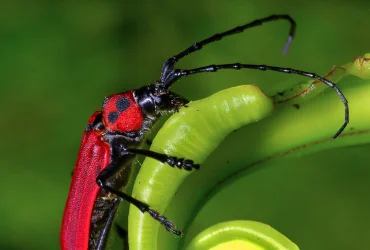 v5i1.96
v5i1.96ISSN: 1800-427X (print)
eISSN: 1800-427X (online)
DOI:10.47605/tapro.v5i1.96
Submitted date: 27 March 2013
Accepted date: 22 April 2013
Published date: 15 June 2013
Pp. 75–76.
First record of a cerambycid beetle (Purpuricenus temminckii) from India
H.V. Ghate* & B. Mitra
*Corresponding author. E-mail: hemantghate@gmail.com
While documenting cerambycid beetles collected by ZSI during routine surveys of Arunachal Pradesh, India, we came across an interesting specimen of the genus Purpuricenus Dejean, 1821. Generic characters of this beetle were confirmed to be of Purpuricenus using Gahan (1906) but the characters did not match with any species described therein. However, it matched closely with Purpuricenus sinensis described very briefly in Latin and English by White (1835). It was then compared with the pictures, presented as a photo gallery of the genus Purpuricenus, prepared by Denis Kasatkin (http://www.zin.ru) and also many other images from a recent paper (Danilevsky 2012) as well as with comments in MacRae (2000) and identified as Purpuricenus temminckii Guérin–Méneville. Purpuricenus sinensis is, in fact, now a synonym of P. temminckii and is treated as a subspecies Purpuricenus temminckii sinensis White which is distributed in many parts of China, Taiwan and Laos.
Section Editor: Eduard Vives
eISSN: 1800-427X (online)
DOI:10.47605/tapro.v5i1.96
Submitted date: 27 March 2013
Accepted date: 22 April 2013
Published date: 15 June 2013
Pp. 75–76.
First record of a cerambycid beetle (Purpuricenus temminckii) from India
H.V. Ghate* & B. Mitra
*Corresponding author. E-mail: hemantghate@gmail.com
While documenting cerambycid beetles collected by ZSI during routine surveys of Arunachal Pradesh, India, we came across an interesting specimen of the genus Purpuricenus Dejean, 1821. Generic characters of this beetle were confirmed to be of Purpuricenus using Gahan (1906) but the characters did not match with any species described therein. However, it matched closely with Purpuricenus sinensis described very briefly in Latin and English by White (1835). It was then compared with the pictures, presented as a photo gallery of the genus Purpuricenus, prepared by Denis Kasatkin (http://www.zin.ru) and also many other images from a recent paper (Danilevsky 2012) as well as with comments in MacRae (2000) and identified as Purpuricenus temminckii Guérin–Méneville. Purpuricenus sinensis is, in fact, now a synonym of P. temminckii and is treated as a subspecies Purpuricenus temminckii sinensis White which is distributed in many parts of China, Taiwan and Laos.
Section Editor: Eduard Vives
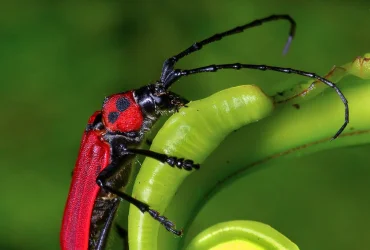 v5i1.95
v5i1.95ISSN: 1800-427X (print)
eISSN: 1800-427X (online)
DOI:10.47605/tapro.v5i1.95
Submitted date: 14 June 2012
Accepted date: 28 November 2012
Published date: 15 June 2013
Pp. 73–74.
Lyriothemis acigastra: A new addition to the odonata fauna of Peninsular India
K.G. Emiliyamma*, M.J. Palot, C. Radhakrishnan & V.C. Balakrishnan
*Corresponding author. E-mail: kgemily@gmail.com
The exclusively old world genus Lyriothemis Brauer, 1868 (Anisoptera: Libellulidae), with 15 species, is widespread across Asian countries occurring in Bangladesh, Tibet, North East India, Myanmar, Thailand, Nepal, Laos, Vietnam, Hong Kong, etc. Of these, L. acigastra (Selys, 1878), L. bivittata (Rambur, 1842), L. cleis (Brauer, 1868) and L. tricolor Ris, 1919 are so far known from India of which all are restricted to Assam and West Bengal, the northeastern part of the country. Here we report this species from South India (Kerala). Based on a photograph of this species taken by the junior co–author, we conducted surveys to locate the specimens in the midland laterite hill areas of North Kerala. We found individuals in Aravanchal and Madayipara areas in Kannur District of North Kerala during July to September, 2010.
Section Editor: Rosser Garrison
eISSN: 1800-427X (online)
DOI:10.47605/tapro.v5i1.95
Submitted date: 14 June 2012
Accepted date: 28 November 2012
Published date: 15 June 2013
Pp. 73–74.
Lyriothemis acigastra: A new addition to the odonata fauna of Peninsular India
K.G. Emiliyamma*, M.J. Palot, C. Radhakrishnan & V.C. Balakrishnan
*Corresponding author. E-mail: kgemily@gmail.com
The exclusively old world genus Lyriothemis Brauer, 1868 (Anisoptera: Libellulidae), with 15 species, is widespread across Asian countries occurring in Bangladesh, Tibet, North East India, Myanmar, Thailand, Nepal, Laos, Vietnam, Hong Kong, etc. Of these, L. acigastra (Selys, 1878), L. bivittata (Rambur, 1842), L. cleis (Brauer, 1868) and L. tricolor Ris, 1919 are so far known from India of which all are restricted to Assam and West Bengal, the northeastern part of the country. Here we report this species from South India (Kerala). Based on a photograph of this species taken by the junior co–author, we conducted surveys to locate the specimens in the midland laterite hill areas of North Kerala. We found individuals in Aravanchal and Madayipara areas in Kannur District of North Kerala during July to September, 2010.
Section Editor: Rosser Garrison
Hubungi Kami
The ultimate aim of the journal is to provide an effective medium for communication of the latest and best scientific information.
Copyright © 2020 Taprobanica. All Rights Reserved
Jasa Pembuatan Website by IKT




